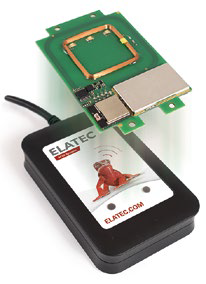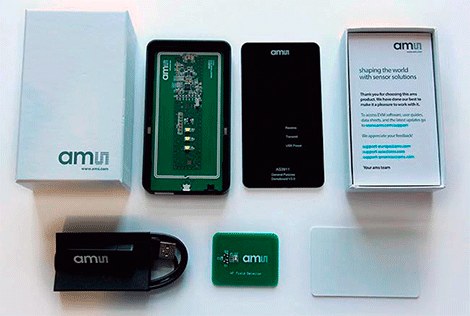Devices that use RFID technology for identification are widely used in logistics, forwarding, or warehouse management. However, the large number of solutions available and the frequent need to integrate them into a single, coherent system can be problematic and time consuming. Solutions offered by Elatec allow you to reduce the cost and time required to integrate new solutions into existing systems. The dynamically developing markets for RFID systems and wireless communication pose new challenges for equipment manufacturers and solution integrators. They concern not only electromagnetic compatibility, but also the choice of identification standard and the type of transponder systems used and the readers or programmers that support them. Regardless of the area of application, the key element is choosing the correct RFID technology used for identification. Your selection will depend on a number of factors, such as the expected range, the type of objects identified, and whether two-way communication with the transponder is required.
Some of these systems, in addition to the possibility of storing a unique identifier in permanent memory, also allow non-volatile storage of data and, at the same time, encrypt communication with the higher system. The choice of technology used for identification is even more important as many different RFID standards operate in parallel, differing in the frequency band used (and therefore the dimensions of the antenna and transponder systems), range, type of modulation, data transmission rate, etc. It can lead to a situation where newly introduced solutions will differ in terms of communication standards from those used up to now. An example of such a problem is the office building, which uses RFID technology to record working time and control access to rooms. In such a building, at some point, it may be necessary to integrate an additional system that allows specific employees to access printers or copiers, also equipped with RFID readers. However, in general, the readers installed in them will work using a different data transmission standard than the one used in the access control system. This situation may force employees to use two or more cards: one to access the workplace and one or more for identification by a printer or copier.
Multi-system readers / programmers
This problem was seen by Elatec, a well-known manufacturer of solutions for RFID systems. The company offers ready-to-use universal reader/programmers connected to the host system via a serial interface and OEM housing-less RFID modules. Ready reader/programmers typically support RS232 or USB communication, while OEM modules also support many other standards, giving the designer room to maneuver and easily adjust the reader/programmer to available hardware resources. It is worth using specific examples. The TWN4 Multitech LEGIC 42 type reader (photo 1) available in the TME offer works in many frequency bands that differ significantly from each other, i.e. 125 kHz, 134,2 kHz, 13,56 MHz. The reader is equipped with RS232 and USB interfaces. The manufacturer provides drivers for Windows and Linux. This type of reader is also offered as an OEM module. In this version, besides the ones mentioned above, you can also cooperate with the master system by means of serial interfaces (logic level 3.3V, tolerance 5V CMOS, I2C). In special versions, it can also communicate via SPI, Wiegand, CAN and 1-wire interfaces. Support for transponders from many manufacturers is available from the radio interface side, among others. Atmel (now Microchip), EM, ST, NXP, Texas TI, HID, LEGIC and others working with ISO14443A/B, ISO15693, ISO18092/ECMA-340 (NFC), HITAG, UNIQUE, ISO14443 A+B (Mifare DESFire EV1 , Mifare Plus, Mifare SmartMX, my-d move, PayPass, etc.), ISO15693 (EM4035, Tag-It, my-d proximity, ICODE SLI), Mifare Classic, Mifare Ultralight, Sony FeliCa, NFC Forum Tag Type 2 - 4, PicoPass, HID, and CLASS. A radio antenna operating in the 125 kHz / 134 kHz / 13.56 MHz band used by these standards has been integrated into the reader board. In addition to interfacing with the master system, the reader also has eight GPIO outputs, which can be used to control a cooperative lock, signal diode, sound signal, etc., and its mode of operation can be programmed using a script language.
smartphone identification
It's worth noting that in addition to compatibility with most RFID technologies, the reader/programmer is also compatible with NFC and Bluetooth (BLE) low energy technologies used in consumer devices such as a smartphone or tablet. Thanks to this, you cannot use RFID cards for identification, and instead you can use, for example, a smartphone with the appropriate application installed. The reader is compatible with the most popular models such as iPhone and smartphones with Android and Windows operating systems. By sticking to the example of an office building, the use of Elatec readers avoids identification problems. Alternatively, instead of carrying one or more cards, it is sufficient to equip employees' smartphones with the appropriate application. For those who use OEM modules, the fact that Elatec stands behind their production will definitely be important, guaranteeing with their reputation their compliance with EMC standards, production standards (eg RoHS 2) and their reliability. More information is available on the TME dealer website.
script language
The manufacturer provides a software package for creating reader applications so that the functionality can be automated using scripts that are directly supported by the reader's processor. In addition, the script can be modified at any time and thanks to this, after receiving a command to change the operating mode, the reader can work with a different RFID standard. In the TWN4 module discussed above, changes can be made using the wireless interface or the configuration card offered by Elatec. This is a great convenience for service technicians who, if necessary, do not waste time disassembling embedded devices, being able to perform the required reconfiguration in a non-invasive manner.
Recognition of RFID technology
In migration scenarios from one system to another, as in the example office building described above, recognition of the currently used RFID technology is necessary to be able to propose a new and optimal solution. Normally, for this purpose, it would be necessary to send the supplier or integrator the RFID card used in the existing application. This lengthy procedure is no longer necessary thanks to Elatec's RFID analysis tools like TechTracer Lite. You can recognize RFID technology in the field used in a solution that already works. As a result, both the solution provider and the customer save time, cost, and the risk of potential errors.
For more information visit: www.tme.eu/en





